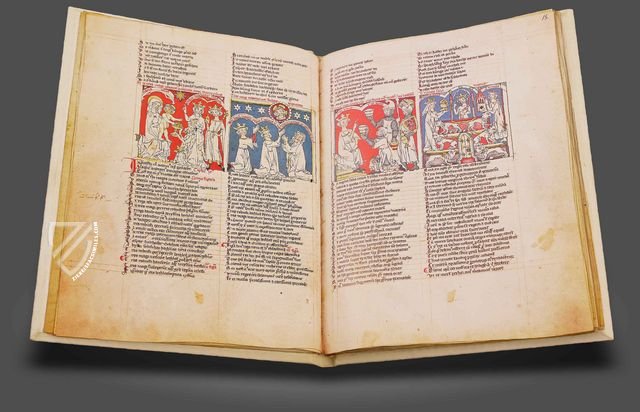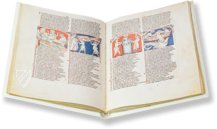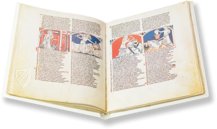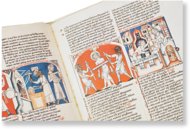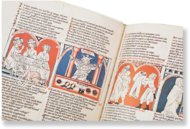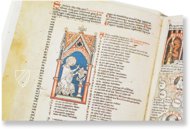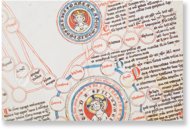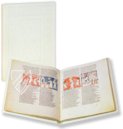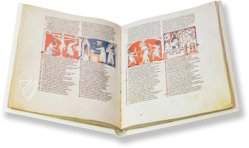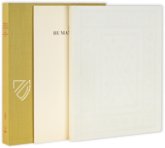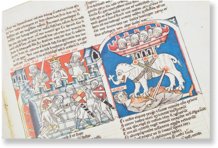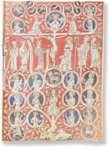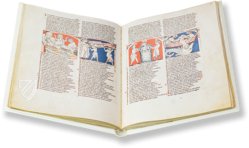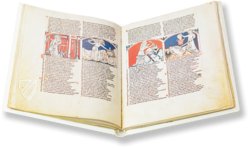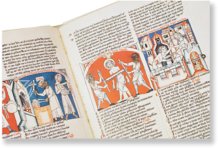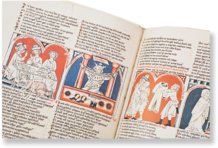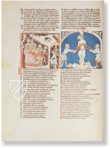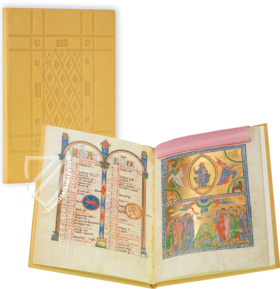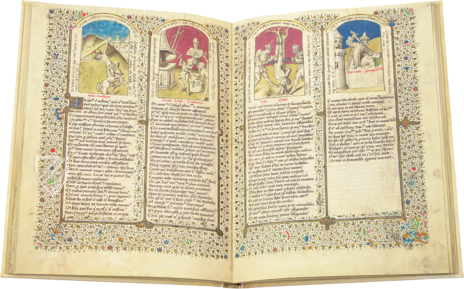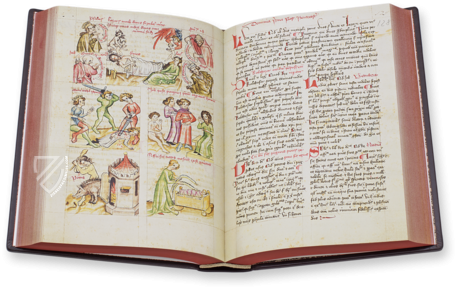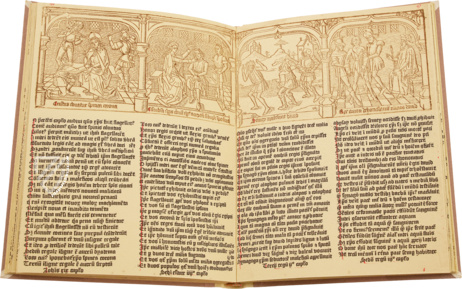Speculum Humanae Salvationis of Kremsmünster
(under 1,000€)
The most popular book of religious edification and one of the most widespread works of the Late Middle Ages: the Speculum Humanae Salvationis or “Mirror of Human Salvation” is the so-called codex Cremifanensis 243, housed today in the Benedictine Abbey of Kremsmünster in Austria. Featuring 192 miniatures and a text in both Latin and German, it is the oldest illuminated manuscript of its type and one of the most lavishly decorated. The primary focus of the work is establishing an extensive synthesis of the Christian history of salvation. This is done by showing the close relation between the New and the Old Testaments. On the other hand, everyday objects are represented: architecture and vestments provide an interesting insight into the culture of the early 14th century, making the manuscript a true treasure trove for the cultural history of this period.
Speculum Humanae Salvationis of Kremsmünster
One of the most beautiful and ancient manuscripts of the Speculum Humanae Salvationis or “Mirror of Human Salvation” is the so-called codex Cremifanensis 243, housed today in the Benedictine Abbey of Kremsmünster in Austria. Its 192 miniatures, all feather drawings outlined by a sure hand and with a great feel for the use of space, are sparsely colored in red and blue and make the reader familiar with the very foundations of Christian belief. This codex is not only the oldest illustrated manuscript of the Speculum Humanae Salvationis but also its first bilingual edition, containing the original Latin text and a somewhat abridged German version. The Speculum Humanae Salvationis is a mirror of human redemption by Jesus Christ and the Virgin Mary, a picture Bible containing systematically compiled accounts from both the Old and the New Testaments, thus forming an extensive synthesis of the Christian history of salvation.
The Pictures – Impressive Reflections of Their Period
The true value of the Kremsmünster manuscript resides in its numerous miniatures which, in outspoken simplicity, greatly impress the beholder. Blue and red backgrounds alternate while the figures emerge before them in the natural color of the parchment. Their faces are generally lit with friendliness, charm, and a sympathetic mood. Evil faces, in contrast, are smeared in black. Everyday objects are represented: architecture and vestments provide an interesting insight into the culture of the early 14th century, making the manuscript a true treasure trove for the cultural history of this period.
A Late Medieval Book for Religious Edification
The Speculum shows the close relation between the New and the Old Testaments, in a number of archetypal series, each of which treats four episodes in both picture and text. A so-called anti-type opens the series with an event of salvation taken from the canon of the New Testament, thus determining the subject being treated. This is followed by three relevant preview scenes from the Old Testament. The interrelation of these four events allows the reader to apprehend the inner context of the salvation topic treated. The presentation offers a synthetic view of God’s plan of salvation, as declared both in the Old and in the New Union. Though the Salvation deed of God according to the New Testament is always preferred as the greater achievement. The great number of biblical scenes shown, and not least its extensive illustration cycle, have made the Speculum Humanae Salvationisthe most popular book of religious edification and one of the most widespread works of the Late Middle Ages.
Codicology
- Alternative Titles
- Heilsspiegel
Spiegel des menschlichen Heils
Way to Human Salvation
Mirror of Human Salvation
Codex Kremsmünster
Speculum Humanae Salvationis - Size / Format
- 124 pages / 33.5 × 25.5 cm
- Origin
- Austria
- Date
- 1325–1330
- Epochs
- Style
- Genre
- Illustrations
- 192 miniatures in the approx. size 80 x 80 mm, alternately on blue or red ground
Speculum Humanae Salvationis of Kremsmünster
Jesse Tree
This literal family tree tracing the genealogy of Jesus Christ is typically found before the Gospel of Matthew. As usual, the father of King David, Jesse, is depicted in repose at the root of the tree that grows from his side. The branches are filled with various biblical figures from that illustrious line while the trunk consists of a Madonna with Child, which in turn leads into a medallion with the Lamb of God. Expensive red paint was used to color the background.
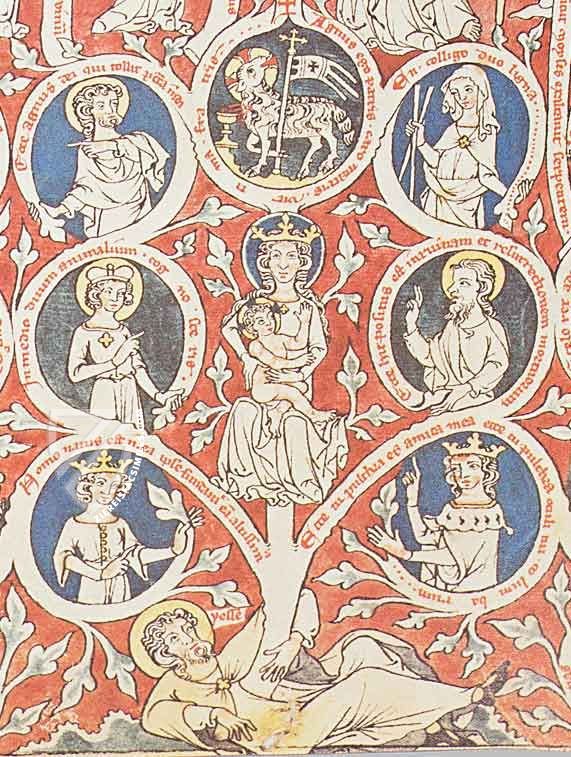
Sacramentary of Metz
Adoration of the Magi / Presentation in the Temple
This is a fine example of the 192 sparsely colored but nonetheless highly refined miniatures in this manuscript, which alternate between red and blue backgrounds. The scene exhibits a great sense of space and the figures’ faces are generally characterized by sympathetic, friendly, and charming expressions. Their garments are portrayed with a very realistic fall of folds.
One the left we see the Three Magi: one kneels to the enthroned Madonna and Child presenting a gift while the other two talk amongst themselves as one of them points out the star that guided them to Bethlehem. In the scene to the right, the baby Jesus is shown in the moment that he is being handed over to Simeon at the altar as he looks back at his mother.
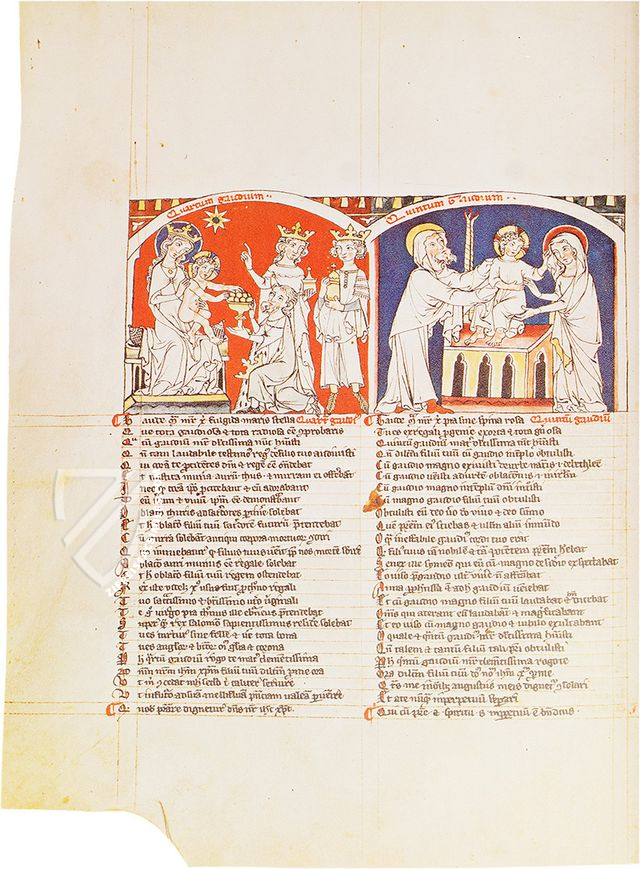
#1 Speculum Humanae Salvationis aus Kremsmünster
Language: German
The scholarly commentary volume describes the content of the work as well as its illuminations and explains the typological structure of the Speculum.
(under 1,000€)
- Treatises / Secular Books
- Apocalypses / Beatus
- Astronomy / Astrology
- Bestiaries
- Bibles / Gospels
- Chronicles / History / Law
- Geography / Maps
- Saints' Lives
- Islam / Oriental
- Judaism / Hebrew
- Single Leaf Collections
- Leonardo da Vinci
- Literature / Poetry
- Liturgical Manuscripts
- Medicine / Botany / Alchemy
- Music
- Mythology / Prophecies
- Psalters
- Other Religious Books
- Games / Hunting
- Private Devotion Books
- Other Genres
- Afghanistan
- Armenia
- Austria
- Belgium
- Belize
- Bosnia and Herzegovina
- China
- Colombia
- Costa Rica
- Croatia
- Cyprus
- Czech Republic
- Denmark
- Egypt
- El Salvador
- Ethiopia
- France
- Germany
- Greece
- Guatemala
- Honduras
- Hungary
- India
- Iran
- Iraq
- Israel
- Italy
- Japan
- Jordan
- Kazakhstan
- Kyrgyzstan
- Lebanon
- Liechtenstein
- Luxembourg
- Mexico
- Morocco
- Netherlands
- Palestine
- Panama
- Peru
- Poland
- Portugal
- Romania
- Russia
- Serbia
- Spain
- Sri Lanka
- Sweden
- Switzerland
- Syria
- Tajikistan
- Turkey
- Turkmenistan
- Ukraine
- United Kingdom
- United States
- Uzbekistan
- Vatican City
- A. Oosthoek, van Holkema & Warendorf
- Aboca Museum
- Ajuntament de Valencia
- Akademie Verlag
- Akademische Druck- u. Verlagsanstalt (ADEVA)
- Aldo Ausilio Editore - Bottega d’Erasmo
- Alecto Historical Editions
- Alkuin Verlag
- Almqvist & Wiksell
- Amilcare Pizzi
- Andreas & Andreas Verlagsbuchhandlung
- Archa 90
- Archiv Verlag
- Archivi Edizioni
- Arnold Verlag
- ARS
- Ars Magna
- ArtCodex
- AyN Ediciones
- Azimuth Editions
- Badenia Verlag
- Bärenreiter-Verlag
- Belser Verlag
- Belser Verlag / WK Wertkontor
- Benziger Verlag
- Bernardinum Wydawnictwo
- BiblioGemma
- Biblioteca Apostolica Vaticana (Vaticanstadt, Vaticanstadt)
- Bibliotheca Palatina Faksimile Verlag
- Bibliotheca Rara
- Boydell & Brewer
- Bramante Edizioni
- Bredius Genootschap
- Brepols Publishers
- British Library
- C. Weckesser
- Caixa Catalunya
- Canesi
- CAPSA, Ars Scriptoria
- Caratzas Brothers, Publishers
- Carus Verlag
- Casamassima Libri
- Centrum Cartographie Verlag GmbH
- Chavane Verlag
- Christian Brandstätter Verlag
- Circulo Cientifico
- Club Bibliófilo Versol
- Club du Livre
- CM Editores
- Collegium Graphicum
- Collezione Apocrifa Da Vinci
- Comissão Nacional para as Comemorações dos Descobrimentos Portugueses
- Coron Verlag
- Corvina
- CTHS
- D. S. Brewer
- Damon
- De Agostini/UTET
- De Nederlandsche Boekhandel
- De Schutter
- Deuschle & Stemmle
- Deutscher Verlag für Kunstwissenschaft
- DIAMM
- Droz
- E. Schreiber Graphische Kunstanstalten
- Ediciones Boreal
- Ediciones Grial
- Ediclube
- Edições Inapa
- Edilan
- Editalia
- Edition Deuschle
- Edition Georg Popp
- Edition Leipzig
- Edition Libri Illustri
- Editiones Reales Sitios S. L.
- Éditions de l'Oiseau Lyre
- Editions Medicina Rara
- Editorial Casariego
- Editorial Mintzoa
- Editrice Antenore
- Editrice Velar
- Edizioni Edison
- Egeria, S.L.
- Eikon Editores
- Electa
- Emery Walker Limited
- Enciclopèdia Catalana
- Eos-Verlag
- Ephesus Publishing
- Ernst Battenberg
- Eugrammia Press
- Extraordinary Editions
- Fackelverlag
- Facsimila Art & Edition
- Facsimile Editions Ltd.
- Facsimilia Art & Edition Ebert KG
- Faksimile Verlag
- Feuermann Verlag
- Folger Shakespeare Library
- Franco Cosimo Panini Editore
- Friedrich Wittig Verlag
- Fundación Hullera Vasco-Leonesa
- G. Braziller
- Gabriele Mazzotta Editore
- Gebr. Mann Verlag
- Gesellschaft für graphische Industrie
- Getty Research Institute
- Giovanni Domenico de Rossi
- Giunti Editore
- Graffiti
- Grafica European Center of Fine Arts
- Guido Pressler
- Guillermo Blazquez
- Gustav Kiepenheuer
- H. N. Abrams
- Harrassowitz
- Harvard University Press
- Helikon
- Hendrickson Publishers
- Henning Oppermann
- Herder Verlag
- Hes & De Graaf Publishers
- Hoepli
- Holbein-Verlag
- Houghton Library
- Hugo Schmidt Verlag
- Idion Verlag
- Il Bulino, edizioni d'arte
- ILte
- Imago
- Insel Verlag
- Insel-Verlag Anton Kippenberger
- Instituto de Estudios Altoaragoneses
- Instituto Nacional de Antropología e Historia
- Istituto dell'Enciclopedia Italiana - Treccani
- Istituto Ellenico di Studi Bizantini e Postbizantini
- Istituto Geografico De Agostini
- Istituto Poligrafico e Zecca dello Stato
- Italarte Art Establishments
- Jan Thorbecke Verlag
- Johnson Reprint Corporation
- Josef Stocker
- Josef Stocker-Schmid
- Jugoslavija
- Karl W. Hiersemann
- Kasper Straube
- Kaydeda Ediciones
- Kindler Verlag / Coron Verlag
- Kodansha International Ltd.
- Konrad Kölbl Verlag
- Kurt Wolff Verlag
- La Liberia dello Stato
- La Linea Editrice
- La Meta Editore
- Lambert Schneider
- Landeskreditbank Baden-Württemberg
- Leo S. Olschki
- Les Incunables
- Liber Artis
- Library of Congress
- Libreria Musicale Italiana
- Lichtdruck
- Lito Immagine Editore
- Lumen Artis
- Lund Humphries
- M. Moleiro Editor
- Maison des Sciences de l'homme et de la société de Poitiers
- Manuscriptum
- Martinus Nijhoff
- Maruzen-Yushodo Co. Ltd.
- MASA
- Massada Publishers
- McGraw-Hill
- Metropolitan Museum of Art
- Militos
- Millennium Liber
- Müller & Schindler
- Nahar - Stavit
- Nahar and Steimatzky
- National Library of Wales
- Neri Pozza
- Nova Charta
- Oceanum Verlag
- Odeon
- Orbis Mediaevalis
- Orbis Pictus
- Österreichische Staatsdruckerei
- Oxford University Press
- Pageant Books
- Parzellers Buchverlag
- Patrimonio Ediciones
- Pattloch Verlag
- PIAF
- Pieper Verlag
- Plon-Nourrit et cie
- Poligrafiche Bolis
- Presses Universitaires de Strasbourg
- Prestel Verlag
- Princeton University Press
- Prisma Verlag
- Priuli & Verlucca, editori
- Pro Sport Verlag
- Propyläen Verlag
- Pytheas Books
- Quaternio Verlag Luzern
- Reales Sitios
- Recht-Verlag
- Reichert Verlag
- Reichsdruckerei
- Reprint Verlag
- Riehn & Reusch
- Roberto Vattori Editore
- Rosenkilde and Bagger
- Roxburghe Club
- Salerno Editrice
- Saltellus Press
- Sandoz
- Sarajevo Svjetlost
- Schöck ArtPrint Kft.
- Schulsinger Brothers
- Scolar Press
- Scrinium
- Scripta Maneant
- Scriptorium
- Shazar
- Siloé, arte y bibliofilia
- SISMEL - Edizioni del Galluzzo
- Sociedad Mexicana de Antropología
- Société des Bibliophiles & Iconophiles de Belgique
- Soncin Publishing
- Sorli Ediciones
- Stainer and Bell
- Studer
- Styria Verlag
- Sumptibus Pragopress
- Szegedi Tudomànyegyetem
- Taberna Libraria
- Tarshish Books
- Taschen
- Tempus Libri
- Testimonio Compañía Editorial
- Thames and Hudson
- The Clear Vue Publishing Partnership Limited
- The Facsimile Codex
- The Folio Society
- The Marquess of Normanby
- The Richard III and Yorkist History Trust
- Tip.Le.Co
- TouchArt
- TREC Publishing House
- TRI Publishing Co.
- Trident Editore
- Tuliba Collection
- Typis Regiae Officinae Polygraphicae
- Union Verlag Berlin
- Universidad de Granada
- University of California Press
- University of Chicago Press
- Urs Graf
- Vallecchi
- Van Wijnen
- VCH, Acta Humaniora
- VDI Verlag
- VEB Deutscher Verlag für Musik
- Verlag Anton Pustet / Andreas Verlag
- Verlag Bibliophile Drucke Josef Stocker
- Verlag der Münchner Drucke
- Verlag für Regionalgeschichte
- Verlag Styria
- Vicent Garcia Editores
- W. Turnowski Ltd.
- W. Turnowsky
- Waanders Printers
- Wiener Mechitharisten-Congregation (Wien, Österreich)
- Wissenschaftliche Buchgesellschaft
- Wissenschaftliche Verlagsgesellschaft
- Wydawnictwo Dolnoslaskie
- Xuntanza Editorial
- Zakład Narodowy
- Zollikofer AG

